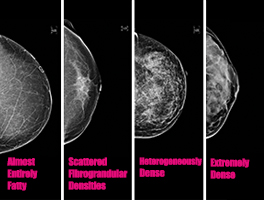
If someone mentioned casually that you have dense breasts, you might feel insulted, proud or confused. In the medical world, dense breasts are totally normal. Still, there’s one thing you need to keep abreast of.
What Are Dense Breasts?
Dense breast tissue refers to how your breast tissue looks on your mammogram (as opposed to fatty, or nondense, breast tissue). The density of your breast tissue depends on how much glandular tissue, fibrous tissue and fat is in your breasts. If you have more fibrous or glandular tissue than fat, your breasts are considered dense. Breast density isn’t anything you can control or treat. It just is what it is.
A handful of things affect your breast density, which can change over time.
- Age. If you’re under 40, you’re more likely to have dense breasts than your friend who’s over 40. About 50% of women 40 and older have dense breasts. Most women lose breast density as they age, with the tissue turning fattier after menopause.
- Breastfeeding. Glandular tissue is the milk-making tissue in the breast. If you breastfeed, you may have dense breasts.
- Heredity. Like mother, like daughter. If your mom has dense breast tissue, you likely will, too.
- Hormones. Birth control pills and hormone replacement therapy can cause dense breast tissue.
- Low body mass index. It may sound strange, but the less body fat you have, the more likely you are to have dense breasts.
What’s the Big Deal?
The big deal is that dense breast tissue may increase your risk for breast cancer. Researchers aren’t sure why, but rest assured they’re trying to figure out the connection. On a mammogram, opens new tab, dense breast tissue appears as solid white areas. So do cancer masses. See the problem? Sometimes it’s tough for a radiologist to tell the difference, and you may need further imaging tests.
Missouri is one of 30 states with a breast density notification law, meaning radiologists are legally obligated to tell you about any health risks posed by your breast density. When you have your mammo done at North Kansas City Hospital, you receive a letter with the results about a week later. The letter also states your breast density and what next steps we recommend, if any.
What Should You Do?
1. Don’t slack off on getting a mammogram, opens new tab every. single. year. The technology is still the best way to detect breast cancer, even in women with dense breasts. We can’t say it enough: Mammograms save lives.
2. Second, get to know your breasts, opens new tab. Check out your girls monthly so you know if something changes. If it does, call your doctor.
3. Lastly, talk with your doctor about whether you might benefit from additional screenings based on your breast cancer risk factors. Additional testing may include an automated breast ultrasound , opens new tabor breast MRI.
October is Breast Cancer Awareness month, so it’s the perfect time to schedule your annual mammogram. Get screened at NKCH anytime in October and get a free tote bag.
Related Articles

November 7, 2024
10000 Steps Good Enough
How many steps did you log today? It’s a popular question, and the gold standard answer is 10,000. Yet, depending on your health goals, you may need to pick up the pace.

June 1, 2019
5 Day Meal Prep
Who says eating healthy has to be difficult? One of our Registered Dietitians shows us how easy it can be to prep lunches for a busy week.

June 1, 2019
5 Foods With Health Benefits
Dark ChocolateBoost your mood and your memory (think antioxidants) by savoring dark chocolate. It may also help your heart health. Just 1 oz. is all it takes...

December 9, 2019
5 Free Indulgences
Are you ready for the hubbub of the holidays? The season’s festivities are always fun, but they can also wear you down. If your holiday spirit needs rechargi...

June 1, 2019
5 Minutes to a Happier You
Feeling stressed, angry or anxious? Head to the great outdoors. A new study has found that a five-minute walk can work wonders for your mood.The more natural...

July 27, 2022
5 Must Have Nutrients
Vitamins and minerals do a body good, but who has time to figure out which foods offer what benefits? This short list of five essential nutrients, opens new ...


